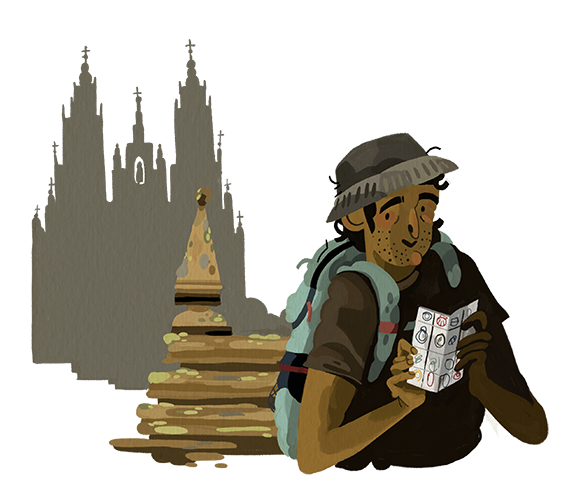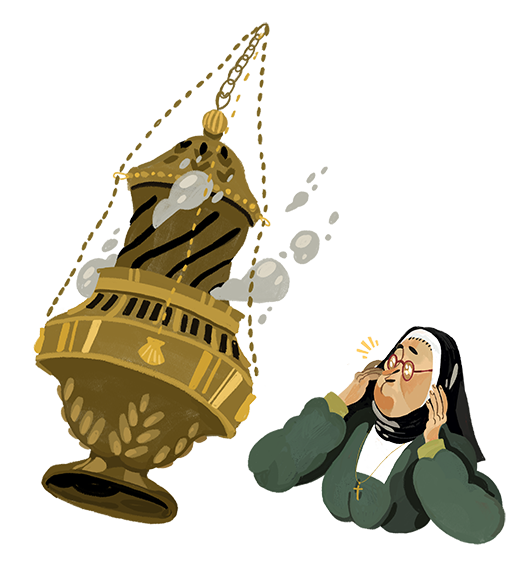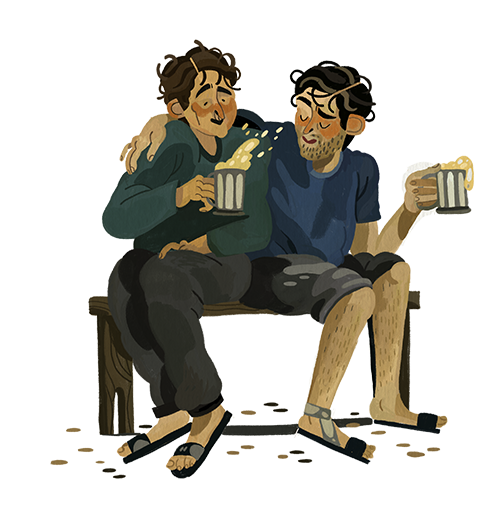Santiago de Compostela
It is somewhat surprising that for most pilgrims, following their long-awaited arrival in the city, their experience is limited to collecting their Compostela certificate, attending the pilgrims’ mass, taking a brief stroll around the historic quarter and treating themselves to a meal, tailored to their budget, followed by a brief farewell celebration with their fellow travellers.
A read of the experiences posted by pilgrims, or the tips given on various forums reveals that typical recommendations include a tour of the market, a walk along the tree-lined alameda avenue, and for the truly curious, a visit to the odd monument.
All in all, the majority only dedicate a day to Santiago, a time which includes their actual arrival in the city. There are various reasons for this. First and foremost is the question of time, as today holidays are tightly scheduled into our busy lives. Secondly, the notion of the finishing point is precisely that; the end of the experience, a release from the tension of long walks, heralding a return to the reassuring routine of everyday life. Despite the city tourist boards’ attempts to convince us otherwise, it should be remembered that pilgrims are not the typical city sightseers, the kind that try to see as much as possible, making the most of their weekend break. Indeed, pilgrims are travellers whose principal motivation was to enjoy the Way to the full, and this experience has now come to an end.

We pilgrims continue to comply with the traditional rituals, some of which now involve certain restrictions (such as the visit to the Portico of Glory), or simply make our way home, fly to the corresponding airport and spending some time in Oporto or Madrid, or even set off in the direction of Fisterra and/or Muxía. Such is the canonical experience, although we have also overheard many admit that they must return in order to explore Santiago de Compostela in greater depth, a wish that extends to other monumental towns and cities along the way that time has prevented them from visiting.
It is precisely for this reason that our recommendations will not include an exhaustive and detailed guide to the sights of Santiago, but instead a few suggestions that may fit in with the interests of the various types of pilgrims.
We know that those who have travelled far feel uneasy when forced to stop in one place for any length of time, and are also aware that pilgrims often feel out of sorts in city environments.
As for the locals, in particular those that have direct contact with them, we would urge them not consider pilgrims as part of the tourist crowd, avoiding an excessively commercial approach. Pilgrims’ overall impression will depend in least partially on their experience of reaching their goal – which is not a place and is more often than not idealised – particularly when emotions are running high.
Must-dos for pilgrims
-The magnificent International Pilgrims’ Reception Centre (Rúa Carretas, 33, Tel. + 34 981 568 846, oficinadelperegrino@catedraldesantiago.es) is a well-organised office with a ticket system, just like those waiting to be served in a bank or supermarket. There is even a QR code that will give you an idea of the average waiting time. Here, we will receive the “final” stamp on our pilgrim’s passport and the Compostela certificate. What you need to know
In the morning, especially before the pilgrims’ mass, the queues are normally longer than at lunchtime or in the afternoon, although this will depend on the number of groups, which increases considerably in the summer months. The opening times are from 8 a.m. to 8 p.m. from Holy Week to Easter, and from 10 a.m. to 7 p.m. the rest of the year. The office is only closed on 25th December and 1st January, when pilgrims should go to the Cathedral sacristy (or, until September 2020, to the Church of San Francsico).
The building houses a chapel for private prayer (mass can also be held there, although advance booking is required). There is a bicycle park, garden, toilets and a tourism information point, post office and booking offices for Renfe (the Spanish national railway) and Alsa (a private coach company).
-If you are not planning to spend the night in the city, we recommend you leave your backpack in one of the many left-luggage offices to be found around the city. This will definitely lighten your load as you make your way around the city streets and enter the various buildings. Remember that backpacks are not allowed inside the Cathedral – only a small rucksack or travel bag.
-If you have already booked your accommodation, but still have not dropped off your luggage, you should do so at the earliest opportunity for precisely the same reason. Ideally, it should be left in a locker or an enclosed and/or supervised area. Being a victim of theft at the eleventh hour could ruin the whole trip. Some accommodation options have a storeroom where guests planning to head on to Fisterra and/or Muxía can leave their backpack free of charge, a welcome relief.
-The pilgrims’ mass, as a farewell blessing, is a ritual tailored for Catholics and Christians in general as well as people of other religions, and even agnostics and atheists. Indeed, beyond the liturgy or sacramental rites, it has an underlying value based on giving thanks to Saint James for guiding us to his house.
This mass is celebrated daily at 12 noon, which is the most popular time (try to arrive early or you may be forced to stand), and also at 7.30 p.m. You may sign up for readings in the Pilgrims’ Office, provided that there are free slots. During the service, the number of pilgrims that have arrived over the last 24 hours is read out, including their starting point along the Way. A truly magnificent finishing touch would be the sight of the vast botafumeiro censer in action, although this means that someone would have had to pay for it.
Until the end of 2020, restoration work inside the basilica means that these masses will be held only at 12 noon in the nearby Church of San Francisco.
Masses for pilgrims are also held in other churches around the city. At certain times of year, these masses are celebrated in German, French, Polish, Italian and English. Liturgy schedules. Unlike in Catalonia, the Church is sadly lacking in its commitment to promoting the Galician language and the only masses said in Galician are held on Sundays and public holidays in the Church of San Fructuoso (10 a.m.) and the Chapel of La Angustia (11.30 a.m.).

-The chance to admire the botafumeiro censer suspended from the cathedral crossing and swinging from one end of the transept to another, skilfully guided by the tiraboleiros or pullers, to the majestic sound of the organ, is a dream come true for any pilgrim.
…when I observe the botafumeiro, I am observing a monument to the Universe. (Álvaro Mutis)
Until 2017, the botafumeiro could be seen in action every Friday afternoon, financed by the local Hotel and Catering Association, Santiago’s Chamber of Commerce and Turismo de Santiago, the city’s tourist board. However, it can now only be seen on major religious festivities – a total of 12 times over the course of the year.
· 6th January. Epiphany.
· Resurrection Sunday.
· Feast of the Ascension.
· 23rd May. Appearance of Saint James at the Battle of Clavijo.
· Feast of Pentecost.
· 25th July. Martyrdom of Saint James. Principal celebration of the city festival.
· 15th August. Feast of the Assumption of the Virgin Mary.
· 1st November. All Saints’ Day.
· Late November. Feast of Christ the King.
· 8th December. Feast of the Immaculate Conception.
· 25th December. Christmas Day.
· 30th December. Transfer of the body of Saint James.
It can also be seen when it has been booked and paid for by a group or VIP event, although no advance announcements are made. In 2019, the cost was €450.
The swinging of this magnificent censer always takes place towards the end of the 12 o’clock mass. In general, and to prevent crowds of tourists flocking into the cathedral merely to “see the show”, admission is forbidden once the mass has begun.
Until the cathedral restoration work is concluded (scheduled for September 2020), the botafumeiro will not be in use.

–Embracing the Apostle. This is undoubtedly the most moving moment for pilgrims visiting the cathedral, and is also popular with tourists, although they will never be able to experience the same sense of connection with Saint James. The 13th century image, placed in a Baroque niche and shrouded in a cloak made of Mexican silver and encrusted with precious stones, a gift from Archbishop Monroy in 1704 (and replaced with a replica in 2004), was designed in the manner of a master welcoming his followers, seated like Saint Peter in Rome.
The ritual of embracing the Apostle has existed since the cathedral was completed. In the Middle Ages, a crown hung from the image against which, in a ritual that began with the Germans, pilgrims would rest their head whilst placing their hat on the Apostle’s head. The constant change of headgear was a source of delight and merriment to all those observing this ritual.
Physical contact with sacred objects is closely tied to the notion of reaching the end of the Way, and an opportunity for all to spend a moment of quiet conversation with Saint James, in particular to give thanks, make a request or remind him of the keeping of a vow. However, the exact content of this conversation is the private realm of each individual.
In the tourist season in particular, long queues tend to form in order to embrace the Apostle, sometimes in pouring rain or under the heat of the midday sun, with waiting times of up to an hour. On such occasions the Abbots’ Door is opened, leading from A Quintana Square and enabling visitors to enter the Cathedral merely to comply with this ritual and see the tomb, before leaving by the Acibechería Door.
–Visiting the tomb of Saint James. Strange as it may seem, or perhaps a sign of the times, many forget that under the cathedral altar lies the crypt opened in 1885, where the silver coffer containing the alleged relics of Saint James the Greater and his disciples Theodorus and Athanasius can be seen. There is a pew in front of the coffer, although it only holds three people at a time. The queue is always much shorter than the one to embrace the figure of Saint James, allowing us to draw a series of conclusions regarding the ‘values’ of contemporary pilgrims, avid followers of the rites of leisure, but with little time for relics.
– Taizé Vespers Service. This is held in the chapel of the International Pilgrims’ Reception Centre at 4.30 p.m. between 15th June and 15th August. It is celebrated in Spanish and English, and includes songs from the French ecumenical community, founded by Brother Roger and made up of Protestants, Catholics and Orthodox Christians, whose work is centred mainly on European Christian youth. For other dates, visit the following Facebook page here.
Prayer vigils are also held in the Cathedral before the Pilgrims’ Mass. Further details are available at the Pilgrims’ Office, although they will not be returning to the Cathedral until 2021.
-We strongly advise calling in at one of the tourist information offices to pick up a map of the city, which also contains details of the city’s amenities, and to find out what’s going on in the city during your stay. You may well be pleasantly surprised by the range of cultural activities, concerts and exhibitions on offer.
-The Pilgrim House (Rúa Nova, 19) is a space designed for quiet contemplation. Opened in 2014 run by a US religious NGO staffed by volunteers from that country. The facilities include a left-luggage office, laundry, toilets, a mediation room and a WiFi room that is free for pilgrims to use. Each day a Grupo Camino Debrief meets to share experiences and to discuss the inner way. It is open from March to October. https://bit.ly/2SfIZ6N
-If you are among the first 10 pilgrims to arrive at the Pilgrims’ Office, you will be treated to breakfast, lunch and dinner at the Hostal de los Reyes Católicos hotel, in keeping with its former status as a Royal Hospital. Before, the fortunate pilgrims had to go to the Parador hotel’s reception desk with a photocopy of their Compostela certificate, but now the process is automatic. The mealtimes are earlier than those for regular diners (lunch is served from 12 noon to 1 p.m.), and the pilgrims sit in the staff dining room. You are more likely to obtain this honour in winter, although the fortunate are few and far between.
-Many will be surprised to learn that a city of the size of Santiago, which each day receives large numbers of pilgrims, has not yet considered organising a programme of cultural or fellowship activities designed specifically for this group. Yet such is the way of the world, where commercial activities take precedence. The indifference of Santiago de Compostela contrasts sharply with the warm welcome proffered in small towns or starting points such as Le Puy-en-Velay, and is another reason why pilgrims fail to linger here.
Consolation comes in numbers, and the gatherings of the friends and companions made along the Way and that arrived at the same time. Faced with a lack of official ideas, we will have to improvise our own.
Not to be missed
 Compostela, and all its beauty, has been forged over the centuries to the beat of the pilgrims’ staffs beating against the paving stones. And whilst it is true that all memories fade into the mists of time, we are fortunate to be able to admire it now, close to completion and perfection, and even more magnificent than when the medieval pilgrim Gaiferos de Mormaltán feasted his weary gaze upon it.
Compostela, and all its beauty, has been forged over the centuries to the beat of the pilgrims’ staffs beating against the paving stones. And whilst it is true that all memories fade into the mists of time, we are fortunate to be able to admire it now, close to completion and perfection, and even more magnificent than when the medieval pilgrim Gaiferos de Mormaltán feasted his weary gaze upon it.
–The Cathedral and its rituals. As a pilgrimage basilica, the Cathedral is currently open to all from 9 m. .to 8 p.m. Admission to the following is separate: the Cathedral Museum and Royal Vault, Reliquary and Treasure, as well as the Archives (home to the famous Codex Calixtinus, which was stolen by an electrician working in the Cathedral in 2011 and was not found until the following year), the crypt beneath the Portico of Glory, the Tribune, Roofs, underground excavations, the adjacent Xelmírez Palace, and, since 2019, the Portico of Glory, unhappily preventing visitors from obtaining a global vision of the temple.
Separating the Portico is a consequence of overtourism; the herds of tourists that sometimes fail to treat this precious heritage with the care it deserves. The decision was adopted following the conclusion of the long restoration project that recovered part of the original polychrome. A fifteen minute visit now costs €10, a special rate for pilgrims which also includes the museum. Opening times are from 9 a.m. to 8 p.m., and from 10 a.m. to 8 p.m. between November and March, although advance booking is advised in the high season.
Since 2009 it is no longer possible to carry out the ritual of placing your hand on the base of the mullion, or gently knocking your forehead against the Santo dos Croques – the stone figure of Master Mateo, who sculptured the magnificent Portico of Glory. Superstition had it that the master would pass on his wisdom to all those that complied with this tradition. This latter tradition was popular among mothers in the 19th century, but the former is rooted in medieval times, and formed part of the contact with sacred elements that stirred pilgrims’ emotions on their arrival at the Cathedral.
This tradition could have been maintained, adding some form of protection to the base of the column and limiting the time to prior to the museum opening hours, as well as reserving the privilege for those pilgrims that had travelled long distances. Yet no consideration was given to these possibilities, a further step forward in the seemingly inevitable conversion of the temple into a museum and commercial venture.
Other rituals that have now disappeared include touching the top of what is believed to have been the staff of Saint James, which, together with that of the pilgrim Franco de Siena, was placed inside a 15th century column-shaped reliquary attached to a pillar in the transept. A tradition that fell into oblivion, and in 2017 it was moved to the Reliquary, which forms part of the museum.
A similar fate befell the Cruz dos Farrapos – or ‘Cross of Rags’. Located on the Cathedral rooftop, tradition had it that pilgrims would burn their ragged clothing here in a ritual of purification. To see this cross, visitors must sign up for the rooftop tour, which is currently suspended. The special rate for pilgrims was €10.
A Corticela Chapel, retains its aura of popular tradition as the “parish of pilgrims, foreigners and Basques”. Several pilgrim couples have been married in this chapel in recent years. It is a place of quiet contemplation and worship, with figures of Our Lady of Miracles, and Christ in the Olive Garden, where traditionally students – and now devotees in general – place their petitions in a basket.
A final element to look out for before leaving the Cathedral is the Holy Door, the entrance to the basilica in Holy Years since the 16th century. What you need to know. This is a rite of passage, providing access to a divine site, and was inspired by a ceremony that was begun in the basilicas of Rome in the 15th century. In the manner of a triumphal arch, this Baroque door is surrounded Saint James and his disciples, portrayed in the style of the 17th century, integrating 24 statues of the Romanesque stone choir sculptured by Master Mateo.
Since 2003, the Holy Door consists of a bronze panel, the work of Suso León. In 2010, and due to the antisocial fetishism of some, the custom whereby the Archbishop opened the door by demolishing the slabs that covered it with a ceremonial hammer was abandoned. Now it is simply unlocked. In holiday season, long queues line up outside this door; it is unfortunate, but worth taking into consideration when considering the best dates to embark on the Way.
Praza do Obradoiro. The most famous of Santiago’s squares is enclosed by the College of San Xerome, which today houses the Vice-Chancellor’s Office of the University of Santiago, and whose Gothic façade was part of the ancient Pilgrims’ Hospital; the Royal Hospital, today the Reyes Católicos parador-hotel, with its elaborate 16th century Plateresque front; the Cathedral’s main façade in the Baroque style, the work of Fernando de Casas y Novoa and which was completed in 1750 and crowned by two twin towers rising up over the original medieval ones; and Raxoi Palace, today the seat of the City Council, a Neoclassical building, with an air of French Classicism attributable to its architect, the engineer Charles Lemaur.
In addition to the spectacle these magnificent buildings provide, which also includes Xelmirez Palace (whose interior dates back to the 12th and 13th centuries), the 16th century Cathedral cloister façade and the 18th century Church of La Angustia de Abajo, this square is also a point of meeting and reunion. A space in which to rest and release your feelings and emotions; for greeting and bidding farewell, complete with its centrally positioned zero mile marker, not always a welcome sight for all.

–Streets lined with wine bars. Celebrating the end of the pilgrimage by indulging in a glass – or two – of wine, together with some of the city’s culinary delights, is not a new custom. The practical guide includes a series of recommendations, but it is common knowledge that in the historic quarter, the bars, taverns and restaurants are all huddled along Franco and Raíña streets, and around the marketplace. Others are scattered along the other streets, with Rúa de San Pedro providing a series of interesting alternatives. Some prefer to avoid the historic quarters, an increasingly crowded tourist haunt, opting instead for eateries in the newer districts or on the city’s outskirts.
– The Food Market. Unsurprisingly, this is the second most visited attraction in town, as apart from being housed in a Neo-medieval building where the various halls remind us of ancient Early Christian basilicas, the stalls are packed with delicious Galician produce. Hall 5 has a number of eateries, including one that for a modest sum will prepare the shellfish you purchase from the fish and seafood stalls. There is also a wine bar. Local farmers sell their produce here on Tuesdays, Thursdays and Saturdays. The market is open from Monday to Saturday between 7 a.m. and 5 p.m., until 4 p.m. on Saturdays and 2 p.m. on Mondays.
– Paseo da Ferradura. This promenade is accessed via the classic Alameda gardens, and affords one of the most spectacular views of the city. On one of the benches you will come across the playwright, poet and novelist Ramón María de Valle-Inclán, who spent many a long hour here admiring the Cathedral. The park itself is rich in symbols, such as the monument to Las Marías, two sisters whose tale is well worth hearing.
Our suggestions
-Discover the Pilgrimage Museum. Of particular interest to pilgrims with a passion for culture, as it provides an insight through art into the history of the phenomenon they now form part of. It hosts fascinating temporary exhibitions, and on the top floor a coffee shop offers panoramic views of the Cathedral. Opening times: Tuesday to Friday from 9.30 a.m. to 8.30 p.m.; Saturdays from 11 a.m. to 7.30 p.m. and Sundays and public holidays from 10.15 a.m. to 2.45 p.m. Admission for pilgrims costs €1.20 and is free on Saturdays from 2.30 p.m. onwards.
-Fans of Baroque art must not miss a visit to San Martiño Pinario, the largest building in the historic quarter. Originally a Benedictine Abbey, today it houses a Seminary, Library, Archive and Hotel. The tour includes the splendid Mannerist church, with its 17th century Baroque masonry and altars. It is open each day from 10 a.m. to 8 p.m. and from 11 a.m. to 7 p.m. between November and May. Admission for pilgrims is €3. If you would like to discover the magnificent 17th century processional cloister, don’t be shy; simply head for the hotel coffee shop and enjoy a drink on the terrace.
-Santiago’s parks will allow you to partially recapture the natural environments that all pilgrims long for. They are ideal for taking in some fresh air, relaxing on the grass or enjoying a picnic. 1. Carballeira de Santa Susana, previously the market ground, surrounded by the Paseo da Ferradura walk and the Alameda gardens, is a traditional Galician oak grove, just like those that we find around chapels and shrines; 2. Bonaval, a delightful spot that includes part of the Dominican monastery kitchen gardens, and which was formerly the municipal cemetery, as the tombs – empty now, of course – indicate; 3. Vista Alegre, the dainty and coquettish former private gardens of the early 20th century villa that belonged to the bourgeoise Simeón family, also the site of the Natural History Museum and a very strange-looking building that houses the Authors’ Society; 4. Galeras, situated close by and situated on the banks of the River Sarela, a tributary of the Sar, with lots of grass to lie on – just the thing for an afternoon nap; and 5. Belvís, nestling on the riverbank between the historic quarter and Belvís monastery and seminary, site of an organic food market on Tuesday afternoons.
-Acquire a taste for the cafés of Santiago: ranging from classics such as Derby, the oldest in town and which opened in 1929, or the Casino, a 19th century building that once housed a cultural association and which since 2002 has been open to the general public. Others, such as Literarios, are first and foremost a viewpoint from which to admire A Quintana Square and the Cathedral. If you’re looking for a leafy garden, then Costa Vella is just the place; Ferradura, in the Alameda park is another option for those with a love of trees – there’s even one inside. Other traditional options include Recantos, with its inner courtyard and excellent music. Alternative venues that are popular with students include La Flor, featuring an attractive décor and standing on the French Way, or Tertulia, at the starting point of the Extension to Fisterra.
-Take the time to discover the Church of Salomé. This ancient temple, which blends in perfectly with the porticoed arches that line Rúa Nova, retains its popular, country air. Highlights include the innocent Gothic Annunciation and the pregnant Virgin, or the large angels wearing glasses hidden in a reredos.
 In this case, it’s a question of “When in Rome, do as the Romans do”, as Santiago is also the end of the pilgrimage route, and if the locals enjoy the taverns, beers and wines on a daily basis, who are we to offend them by demanding a simple cup of tea?
In this case, it’s a question of “When in Rome, do as the Romans do”, as Santiago is also the end of the pilgrimage route, and if the locals enjoy the taverns, beers and wines on a daily basis, who are we to offend them by demanding a simple cup of tea?
-For a contrasting cultural experience, visit the Museum of the Galician People, followed by a tour of the Galician Centre of Contemporary Art (CGAC). A double dose of culture, first to discover the magnificent museum that relates the history of Galicia: its rural and seafaring traditions, homes, trades and beliefs, etc. Yet it also houses a treasure that intrigued the visitors of the past: the triple spiral staircase created by Domingo Antonio de Andrade (1700). Also not to be missed is the Gothic Church of the Mendicant Friars of Saint Dominic, and the Pantheon of Illustrious Galicians, which houses the tombs of Rosalía de Castro or Castelao, amongst others. It is open from Tuesday to Saturday from 10.30 a.m. to 2 p.m. and from 4 p.m. to 7.30 p.m. and on Sundays and public holidays from 11 a.m. to 2 p.m. Tickets cost €3, although admission to the temporary exhibitions and church is free.
The Galician Centre of Contemporary Art (CGAC) is worthy of admiration on the outside as well as inside. The magnificent building was designed by Álvaro Siza Vieira, winner of the 1992 Prizker Architecture Prize, and it also houses excellent temporary exhibitions. The opening hours are from Tuesday to Sunday between 11 a.m. and 8 p.m. Admission is free.
-Fancy taking home a souvenir? Sorry, but we won’t be recommending fridge magnet, mugs with funny phrases, lucky witches or tacky T-shirts, but instead items related to the city’s traditional crafts and artisanship: silver and jet. Less expensive than you would imagine, the medals and charms such as fig signs to ward off evil spirits feature classic designs reminiscent of Celtic forms or contemporary patterns. You are guaranteed to find something to suit all tastes.
-If you didn’t follow the Ourense or Sil ways to Santiago, take the time to visit the former Collegiate Church of Santa María del Sar (open from 11 a.m. to 2 p.m. and from 4.30 p.m. to 8.30 p.m.). Admission is included in the Museum and Portico of Glory tour or €2 if you pay separately. It is a 15 minute walk from the city centre. Highlights include the eye-catching leaning columns of this Romanesque temple, which has three naves and a Romanesque cloister, the work of Master Mateo’s workshop.
–Cidade da Cultura. Debate is ongoing regarding the suitability of installing a cable car providing direct access to the City of Culture from the interchange station or Praza da Constitución, the square behind the Galician parliament building. Its interest lies in the controversial style and cost of this complex, designed by US architect Peter Eisenman and still incomplete, but especially in the temporary exhibitions included in its programme of cultural activities. City bus route 9, which runs every hour from Monday to Friday and on Saturday mornings will take you there (A Serna, Virxe da Cerca or Porta do Camiño bus stops and the fare costs €1). It is open from 11 a.m. to 11 p.m. and the Gaiás Museum Centre, which is where the exhibitions are held, is open from Tuesday to Sunday from 10 a.m. to 8 p.m. (admission is free). You will also be able to admire John Hejduk’s two towers (2002), inspired by the Cathedral towers.
– Sarela Trail. Pilgrims yearning for those treks through the woods along the Way of Saint James will be pleased to learn that the outskirts of Santiago boast a riverside walk that will take them past mills and former tanneries, hidden amongst densely wooded areas. A delightful 30 minute walk from Ponte Sarela to Carme de Abaixo under willows, alder trees, oaks and chestnuts. An absolute pleasure!
–Casa Manolo. Although we are reluctant to include recommendations for specific restaurants in this chapter, there are always exceptions. Casa Manolo, situated in Praza de Cervantes, is a classic restaurant for pilgrims, and for many enjoying a meal here is almost as important as visiting the Cathedral. The secret to its success is the varied and affordable set menu, offering a wide choice of dishes. Queues are likely in the high season, more often at midday than in the evening.
–The Ensanche district. Pilgrims may well feel like fish out of water in this area, but it will offer you an insight into what life is like for many of the locals. High rise buildings, lots of concrete and very few green spaces, but on the plus side, lots of bars where you can still get a good quality tapa for free.
-A great way of bidding farewell to the city is a tour of the bars in the historic district, many of which have a unique character. Examples include the O Galo d’Ouro, with its legendary jukebox; the classic Modus Vivendi, situated in the stables of a palace; Casa das Crechas, ideal for discovering traditional Galician folk music; A Carrilana, in a former carriage house; Atlántico, famous for its cocktails; and Momo, with an interior that recreates a street and a terrace overlooking Belvís.






